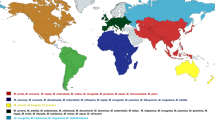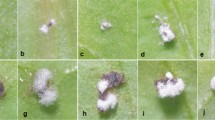Abstract
The aim of the study was to provide information on the fungicide sensitivity of grape powdery mildew (Erysiphe necator) to some of the modes of action used for grape powdery mildew control with a focus on Europe. QoIs: most samples analysed in this study showed high values of the G143A mutation, which leads to low field performance of QoIs. Therefore, QoIs have lost their strength on grape powdery mildew control. DMIs: European wide sensitivity studies indicated that DMIs are only slightly and differently affected by the mutation Y136F, being frequently detected in the pathogens’ cyp51 gene. Mefentrifluconazole was recently developed for grape powdery mildew control, and its sensitivity is even not affected by this mutation. APKs: resistance towards aryl-phenyl-ketones (APKs) has also been reported in various regions in Europe, and monitoring studies showed a heterogenous distribution from a sensitive situation towards populations with higher APK resistance. SDHIs: adaptation of Erysiphe necator to succinate dehydrogenase inhibitors (SDHI) is more recent and quite complex because different mutations can be found in the B and C-subunits of the SDH gene which have different effects on SDHIs. Different mutation pattern in different geographical regions have been found which could be the result of different SDHI use. Therefore, the implementation of resistance management strategies, including the use of various modes of action in alternation and mixture, are recommended for a sustainable disease management in grapes.





Similar content being viewed by others
References
Cherrad S, Charnay A, Hernandez C, Steva H, Belbahri L, Vacher S (2018) Emergence of boscalid-resistant strains of Erysiphe necator in French vineyards. Microbiol Res 216:79–84
Délye C, Laigret F, Corio-Costet MF (1997) A mutation in the 14α-demethylase gene of Uncinula necator that correlates with resistance to a sterol biosynthesis inhibitor. Appl Environ Microbiol 63:2966–3297
FRAC (2023) www.frac.info
Graf S, Zito R, Gold RE, Stammler G (2017) Status of in vivo sensitivity and molecular diagnosis of fungicide resistance in powdery mildews. Mod Fungic Antifung Compd VIII:243–248
Gubler WD, Ypema HL, Ouimette DG, Bettiga LJ (1996) Occurrence of resistance in Uncinula necator to triadimefon, myclobutanil, and fenarimol in California grapevines. Plant Dis 80:902–909
Hoffmeister M, Zito R, Stammler G (2022) Fungicides as efficient tools in integrated control of grape powdery mildew (Erysiphe necator). In: GDPM, BIO Web of Conferences vol 50, pp 03016. https://doi.org/10.1051/bioconf/20225003016
Jones L, Riaz S, Morales-Cruz A, Amrine KC, McGuire B, Gubler WD, Walker MA, Cantu D (2014) Adaptive genomic structural variation in the grape powdery mildew pathogen. Erysiphe Necator BMC Genom 15:1081
Kunova A, Pizzatti C, Bonaldi M, Cortesi P (2016) Metrafenone resistance in a population of Erysiphe necator in northern Italy. Pest Manag Sci 2:398–404
Kunova A, Pizzatti C, Saracchi M, Pasquali M, Cortesi P (2021) Grapevine powdery mildew: fungicides for its management and advances in molecular detection of markers associated with resistance. Microorganisms 9:1541. https://doi.org/10.3390/microorganisms9071541
Miessner S, Mann W, Stammler G (2011) Guignardia bidwellii, the causal agent of black rot on grapevine has a low risk for QoI resistance. J Plant Dis Prot 118:51–53
Vo**ović UD, Adamović J, Ivanović MM, Stević MŽ (2023) Occurrence of resistance in field populations of Erysiphe necator to QoI, azanaphthalene and aryl-phenyl-ketone fungicides in Serbia. Crop Prot. https://doi.org/10.1016/j.cropro.2023.106359
Acknowledgements
The authors thank Xenia Weilacher, Gabriele Berthold and Margit Holzmann for excellent technical assistance.
Author information
Authors and Affiliations
Contributions
RZ and AK organized the field sensitivity monitoring and participated in the data analysis. MH analysed the resistance mechanisms and their effects. GS organized the field trials and the molecular genetic analysis of field samples.
Corresponding author
Ethics declarations
Conflict of interest
The authors are employees of BASF, the manufacturer of pyraclostrobin, mefentrifluconazole, metrafenone and fluxapyroxad.
Ethical approval
The authors followed the ethical standard of the JPDP.
Additional information
Publisher's Note
Springer Nature remains neutral with regard to jurisdictional claims in published maps and institutional affiliations.
Rights and permissions
Springer Nature or its licensor (e.g. a society or other partner) holds exclusive rights to this article under a publishing agreement with the author(s) or other rightsholder(s); author self-archiving of the accepted manuscript version of this article is solely governed by the terms of such publishing agreement and applicable law.
About this article
Cite this article
Zito, R., Hoffmeister, M., Kuehn, A. et al. Current update on the fungicide sensitivity of Erysiphe necator (grape powdery mildew) in Europe. J Plant Dis Prot 131, 1217–1223 (2024). https://doi.org/10.1007/s41348-024-00893-2
Received:
Accepted:
Published:
Issue Date:
DOI: https://doi.org/10.1007/s41348-024-00893-2




